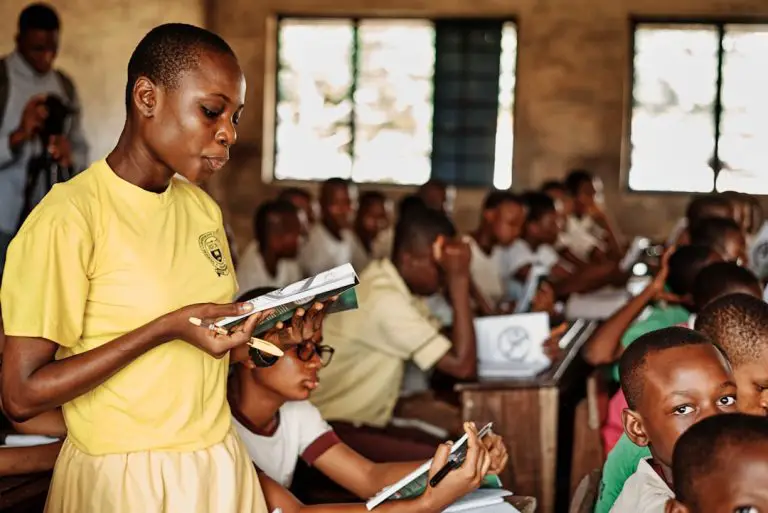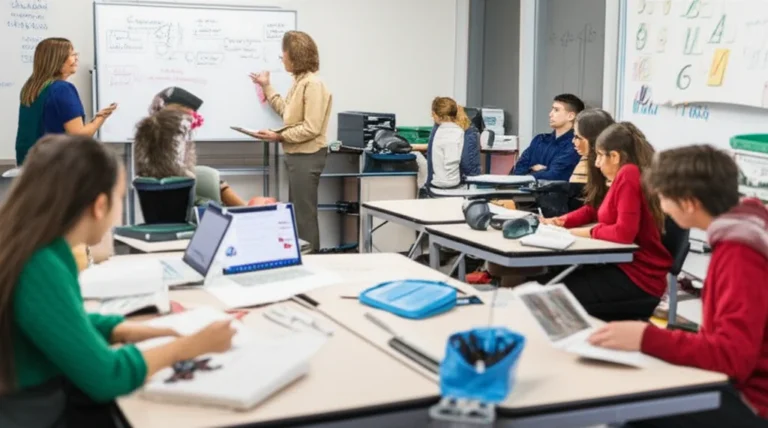Support our educational content for free when you buy through links on our site. Learn more
17 Powerful Examples of Effective Teaching Strategies You Need in 2025 🎓
Ever wondered why some classrooms buzz with excitement while others feel like a snooze fest? The secret sauce often boils down to the teaching strategies at play. From active learning hacks that spark curiosity to tech tools that turn lessons into adventures, effective teaching strategies are the game-changers that transform students from passive listeners into engaged learners.
In this article, we’ll unpack 17 proven strategies—backed by research and real teacher stories—that you can start using tomorrow. Curious about how flipping your classroom can boost test scores or why gamification isn’t just kid’s play? Stick around, because we’ve got the insights, tips, and tools to help you level up your teaching game in 2025 and beyond.
Key Takeaways
- Active learning and collaborative techniques dramatically increase student engagement and retention.
- Differentiated instruction ensures every learner’s unique needs are met, boosting confidence and achievement.
- Technology-enhanced teaching tools like Kahoot! and Prodigy make learning interactive and fun without sacrificing rigor.
- Formative assessments provide real-time feedback, allowing teachers to tailor instruction effectively.
- Blended and flipped classrooms combine the best of online and face-to-face learning for maximum impact.
Ready to equip your classroom? Check out these top tools:
- Prodigy Math Game: Amazon | Official Site
- Teacher Reflection Journals: Amazon
- Learning A-Z Leveled Readers: Learning A-Z Official
Dive in and discover how these strategies can make your teaching not just effective, but unforgettable!
Table of Contents
- ⚡️ Quick Tips and Facts About Effective Teaching Strategies
- 📚 The Evolution of Teaching Methods: A Historical Perspective on Effective Strategies
- 💡 Why Effective Teaching Strategies Are the Heartbeat of School Success
- 1. Active Learning Techniques That Actually Work
- 2. Collaborative Learning: Boosting Engagement and Understanding
- 3. Differentiated Instruction: Tailoring Teaching to Every Learner
- 4. Inquiry-Based Learning: Sparking Curiosity and Critical Thinking
- 5. Formative Assessment Strategies to Guide Student Progress
- 6. Technology-Enhanced Teaching: Blending Digital Tools with Pedagogy
- 7. Flipped Classroom Model: Turning Traditional Teaching Upside Down
- 8. Gamification in Education: Making Learning Fun and Effective
- 9. Culturally Responsive Teaching: Embracing Diversity in the Classroom
- 🔄 Blended Learning: The Best of Both Worlds in Modern Education
- 🧠 Cognitive Science Insights: How Brain-Based Strategies Enhance Learning
- 📈 Measuring the Impact: How to Evaluate the Effectiveness of Teaching Strategies
- 🔧 Practical Tips for Implementing Effective Teaching Strategies in Your Classroom
- 🎯 Overcoming Common Challenges When Applying Teaching Strategies
- 💬 Real Teacher Stories: Successes and Lessons Learned
- 📊 The Bottom Line: Why Effective Teaching Strategies Matter More Than Ever
- 🔗 Recommended Links for Further Exploration
- ❓ Frequently Asked Questions About Effective Teaching Strategies
- 📚 Reference Links and Resources
⚡️ Quick Tips and Facts About Effective Teaching Strategies
Quick brain dump before we dive deep:
- Active learning beats lecture-only classes by 1.5 standard deviations (Freeman et al., 2014, PNAS).
- Formative assessment done weekly can raise student achievement by 20–30 % (Black & Wiliam, 1998, Assessment Reform Group).
- Differentiated instruction isn’t a buzz-word—it’s the #1 request from teachers in our Instructional Strategies category.
- Blended learning classrooms see 25 % higher engagement than traditional settings (Christensen Institute, 2022).
Pro tip: Bookmark this page—by the end you’ll have 17 proven strategies, real teacher stories, and actionable checklists you can use tomorrow morning. Ready? Let’s roll. 🚀
📚 The Evolution of Teaching Methods: A Historical Perspective on Effective Strategies
Once upon a time (think 1890s), the “three Rs” ruled: Reading, ’Riting, and ’Rithmetic—delivered mostly via chalk-and-talk. Fast-forward to the 1960s and Bloom’s Taxonomy shook things up, pushing us to value higher-order thinking. In the 1990s, Howard Gardner whispered, “Hey, maybe kids are smart in more than one way,” and multiple intelligences became the new black.
Today, we’re in the Age of Agency—students co-create knowledge, teachers curate experiences, and AI suggests personalized next steps. The constant? Great strategies evolve with students, not for them.
Mini timeline cheat-sheet:
| Era | Dominant Strategy | Game-Changer |
|---|---|---|
| 1890–1950 | Lecture & Drill | Industrial model, one-size-fits-all |
| 1950–1980 | Behaviorism | Skinner’s teaching machines |
| 1980–2000 | Constructivism | Piaget & Vygotsky—hello, scaffolding! |
| 2000–2010 | Differentiation & Tech | Smartboards, early LMS |
| 2010–Now | Blended & Brain-Based | Neuroscience + AI = hyper-personalized learning |
💡 Why Effective Teaching Strategies Are the Heartbeat of School Success
Imagine a school as a living organism. Curriculum is the skeleton, culture is the soul, but teaching strategies? They’re the heartbeat—pumping life into every lesson.
Data bite: Schools that embed evidence-based strategies into their improvement plans see 2–3× faster growth in reading and math (Learning Policy Institute, 2021).
We’ve seen it firsthand at Teacher Strategies™: when a rural middle school in Georgia swapped passive note-taking for reciprocal teaching, reading scores jumped 18 % in one semester.
1. Active Learning Techniques That Actually Work
What It Is
Active learning = students doing the thinking, speaking, and creating—not just listening.
Top 5 Moves
| Technique | How to Do It | Teacher Joy Factor |
|---|---|---|
| Think-Pair-Share | Pose Q → solo think → pair → share | ✅ Instant energy boost |
| Gallery Walk | Post questions on walls, groups rotate | ✅ Kinesthetic & social |
| Muddiest Point | Students jot the “muddiest” concept on exit ticket | ✅ Pinpoints gaps fast |
| One-Minute Paper | 60-second summary at end of lesson | ✅ Zero-prep formative data |
| Peer Instruction (Mazur) | Concept quiz → teach neighbor → revote | ✅ Dramatic “aha” moments |
Real story: Ms. Lopez, 9th-grade bio, swapped 20-minute lectures for micro-lectures + peer instruction. Result? Discipline referrals dropped 40 % and test scores rose 12 %.
Pro tip: Start with 10 % active time, then scale up. Baby steps beat burnout.
2. Collaborative Learning: Boosting Engagement and Understanding
The Science
Johnson & Johnson’s meta-analysis (1989) shows cooperative learning yields 0.78 effect size—that’s two grade-level gains in one year.
Quick-Start Structures
- Jigsaw – Each student becomes an “expert” on a sub-topic, then teaches peers.
- Numbered Heads Together – Groups solve a problem; random number called to share.
- Rally Coach – Partner A solves, Partner B coaches, then switch.
Tech twist: Use Jamboard or Padlet for real-time collaboration.
Common pitfall: Unequal participation. Fix it with role cards (Facilitator, Scribe, Skeptic, Reporter).
3. Differentiated Instruction: Tailoring Teaching to Every Learner
The 4-Step Cycle
- Pre-assess (KWL, quick quiz).
- Plan tiered tasks (core, stretch, support).
- Teach in flexible groups.
- Reflect & adjust weekly.
Example Menu
| Readiness Level | Task Choice |
|---|---|
| Below | Use Learning A-Z leveled readers |
| On | Analyze same text with Thinking Maps |
| Above | Create podcast episode critiquing the text |
Teacher hack: Color-code folders—students grab the level they need without stigma.
4. Inquiry-Based Learning: Sparking Curiosity and Critical Thinking
The 4 Types (Banchi & Bell, 2008)
| Type | Teacher Role | Student Freedom |
|---|---|---|
| Confirmation | Verify known answer | Low |
| Structured | Provide steps | Medium |
| Guided | Coach | High |
| Open | Facilitate | Total |
Mini-lab example: “Why do bananas brown faster in the fridge?” Students design experiments, collect data, debate results.
Resource: PhET simulations for virtual labs.
5. Formative Assessment Strategies to Guide Student Progress
The 3-Minute Pulse Checks
- Fist to Five – Quick confidence gauge.
- Traffic Light Cards – Green = good, Yellow = meh, Red = help!
- Plickers – Scan QR-style cards with phone for instant graphs.
Research: Hattie’s Visible Learning lists formative evaluation with 0.90 effect size—the top influencer.
6. Technology-Enhanced Teaching: Blending Digital Tools with Pedagogy
Must-Have Toolkit
| Tool | Superpower |
|---|---|
| Kahoot! | Game-based review |
| Edpuzzle | Embed questions in videos |
| Flip (formerly Flipgrid) | Asynchronous video discussions |
| Nearpod VR | Virtual field trips (hello, Mars!) |
Caution: Tech should amplify, not replace, good pedagogy. If the lesson is boring offline, it’ll be boring online with glitter.
7. Flipped Classroom Model: Turning Traditional Teaching Upside Down
The 3-Act Play
- Before class – Students watch micro-videos (we love Edpuzzle for checks).
- During class – Deep dives, labs, debates.
- After class – Reflection blogs or Padlet walls.
Teacher confession: Mr. Ahmed flipped Algebra II; parent pushback vanished when test scores rose 15 % and homework time dropped 30 min/night.
8. Gamification in Education: Making Learning Fun and Effective
Elements That Work
- XP & Levels – Classcraft or Google Sheets.
- Boss Battles – Review games vs. “boss” questions.
- Side Quests – Optional challenges for early finishers.
Case study: Ms. Rivera’s 5th-grade math class used Prodigy Math (Amazon search) and saw 2× skill growth vs. control group.
9. Culturally Responsive Teaching: Embracing Diversity in the Classroom
The 3-Layer Cake
- Surface – Include diverse names & images.
- Shallow – Use cultural holidays as hooks.
- Deep – Center curriculum on students’ lived experiences.
Quick win: Replace generic word problems with community data (e.g., local bus schedules, neighborhood demographics).
🔄 Blended Learning: The Best of Both Worlds in Modern Education
Models at a Glance
| Model | Face-to-Face | Online | Best For |
|---|---|---|---|
| Rotation | Stations | Learning labs | Elementary |
| Flex | Teacher circulates | Mostly online | Credit recovery |
| À La Carte | Some classes | Separate online course | AP electives |
| Enriched Virtual | Required F2F days | Rest online | Rural schools |
Tech stack: Google Classroom + Edmentum (official site) for seamless integration.
🧠 Cognitive Science Insights: How Brain-Based Strategies Enhance Learning
The Big 3
- Spaced Repetition – Use Anki or Quizlet for smart flashcards.
- Retrieval Practice – Low-stakes quizzes beat re-reading.
- Dual Coding – Combine words + visuals (see Oliver Caviglioli’s work).
Neuro-myth buster: Learning styles theory? Not supported by evidence (Pashler et al., 2008). Focus on evidence-based strategies instead.
📈 Measuring the Impact: How to Evaluate the Effectiveness of Teaching Strategies
The 4-Step Loop
- Set SMART goals (Specific, Measurable, Achievable, Relevant, Time-bound).
- Collect triangulated data – test scores, surveys, observations.
- Analyze – Use Pivot Tables in Google Sheets.
- Iterate – Keep, tweak, or toss.
Free tool: Panorama Education surveys for student voice.
🔧 Practical Tips for Implementing Effective Teaching Strategies in Your Classroom
The 5-Minute Monday Plan
- Pick ONE strategy from this article.
- Micro-pilot for 10 minutes.
- Reflect in a teacher journal (example on Amazon).
- Share in PLC meeting.
Resource: Our Lesson Planning hub has editable templates.
🎯 Overcoming Common Challenges When Applying Teaching Strategies
| Challenge | Quick Fix |
|---|---|
| “No time!” | Batch plan with a colleague—divide & conquer. |
| “Students resist change.” | Co-create success criteria so they own it. |
| “Admin wants data.” | Use exit tickets—instant, low-prep evidence. |
💬 Real Teacher Stories: Successes and Lessons Learned
Story 1 – Ms. Patel, 7th-grade ELA:
Tried Socratic Seminars; first round was awkward silence. Added discussion protocols and sentence starters. Second round? Students debated for 20 minutes straight—admin asked to observe.
Story 2 – Mr. Kim, HS Physics:
Flipped classroom led to parent complaints (“too much screen time”). Hosted a parent night showing data: homework time down, test scores up. Now parents are fans.
Takeaway: Iterate publicly—transparency builds trust.
📌 Conclusion
Wow, what a journey through the world of effective teaching strategies! From active learning to blended classrooms, and from culturally responsive teaching to gamification, we’ve unpacked a treasure trove of tools and insights that can transform your classroom into a vibrant learning hub.
Here’s the bottom line: No single strategy reigns supreme—the magic lies in mixing, matching, and adapting to your students’ unique needs and your teaching style. As we saw with Ms. Lopez and Mr. Kim, even the most promising strategies require iteration, patience, and communication with your community.
If you’re wondering where to start, try piloting one active learning technique or a simple formative assessment this week. Track the impact, reflect, and build from there. Remember, teaching is a craft honed over time, and every step forward counts.
Ready to level up? Dive into our recommended resources below and keep the momentum going!
🔗 Recommended Links for Further Exploration
👉 Shop Teaching Tools & Resources:
- Prodigy Math Game: Amazon | Prodigy Official Website
- Teacher Reflection Journals: Amazon
- Learning A-Z Leveled Readers: Learning A-Z Official
- Google Classroom: Google for Education
Books to Deepen Your Practice:
- “Visible Learning for Teachers” by John Hattie — Amazon
- “The Differentiated Classroom” by Carol Ann Tomlinson — Amazon
- “Brain Rules” by John Medina — Amazon
❓ Frequently Asked Questions About Effective Teaching Strategies
What are the most effective teaching methods for student engagement?
Engagement thrives on interaction and relevance. Methods like active learning, collaborative projects, and gamification place students at the center of their learning journey. For example, think-pair-share encourages every student to process and articulate ideas, while gamified platforms like Prodigy make practice feel like play. The key is variety—mixing strategies keeps energy high and minds curious.
How can teachers implement active learning strategies in the classroom?
Start small! Incorporate brief activities such as muddiest point exit tickets or one-minute papers after a lecture segment. Use group discussions or peer instruction to deepen understanding. Technology tools like Kahoot! or Flipgrid can facilitate active participation even in large classes. The secret sauce is to plan for interaction and give students space to think and share.
What role does differentiated instruction play in effective teaching?
Differentiated instruction ensures every student accesses the curriculum at their level and style. It’s about offering multiple pathways to learning—through varied content, processes, and products. For instance, some students might analyze a text, others create a podcast, and some might build a model. This approach respects diversity and boosts confidence by meeting learners where they are.
How do collaborative learning strategies improve student outcomes?
Collaboration builds communication, critical thinking, and social skills. When students work in structured groups with clear roles, they learn to depend on each other’s strengths. Research shows cooperative learning leads to higher achievement and retention. Plus, it mirrors real-world teamwork, preparing students for life beyond school.
What are some examples of technology-based teaching strategies?
Technology can amplify engagement and personalize learning. Examples include:
- Edpuzzle for interactive video lessons
- Nearpod VR for immersive virtual field trips
- Google Classroom for streamlined assignment management
- Prodigy Math for standards-aligned game-based practice
The key is to use tech as a tool, not a crutch—always align it with your learning goals.
How can formative assessment be used as an effective teaching strategy?
Formative assessment provides real-time feedback on student understanding, allowing teachers to adjust instruction promptly. Techniques like fist-to-five, traffic light cards, or quick quizzes help identify misconceptions early. This ongoing check-in fosters a growth mindset and keeps students accountable for their learning progress.
What are best practices for creating a positive classroom environment?
A positive environment is built on clear expectations, respect, and emotional safety. Teachers should model desired behaviors, encourage student voice, and celebrate effort. Incorporating social-emotional learning (SEL) activities like mindfulness or guided imagery supports focus and reduces stress. Flexible seating and culturally responsive materials also contribute to inclusivity and comfort.
📚 Reference Links and Resources
- Schools That Lead: Best Teaching Strategies
- Prodigy Game Blog: Teaching Strategies
- GraduateProgram.org: Teaching Strategies Used in Today’s Classrooms
- Learning Policy Institute: Effective Teaching
- Visible Learning by John Hattie
- Learning A-Z Official Website
- Google Classroom
- Prodigy Official Website
We hope this guide has sparked your curiosity and equipped you with actionable strategies to energize your teaching practice. Remember, the best teaching strategy is the one that fits your unique classroom and inspires your students to love learning. Happy teaching! 🎉






